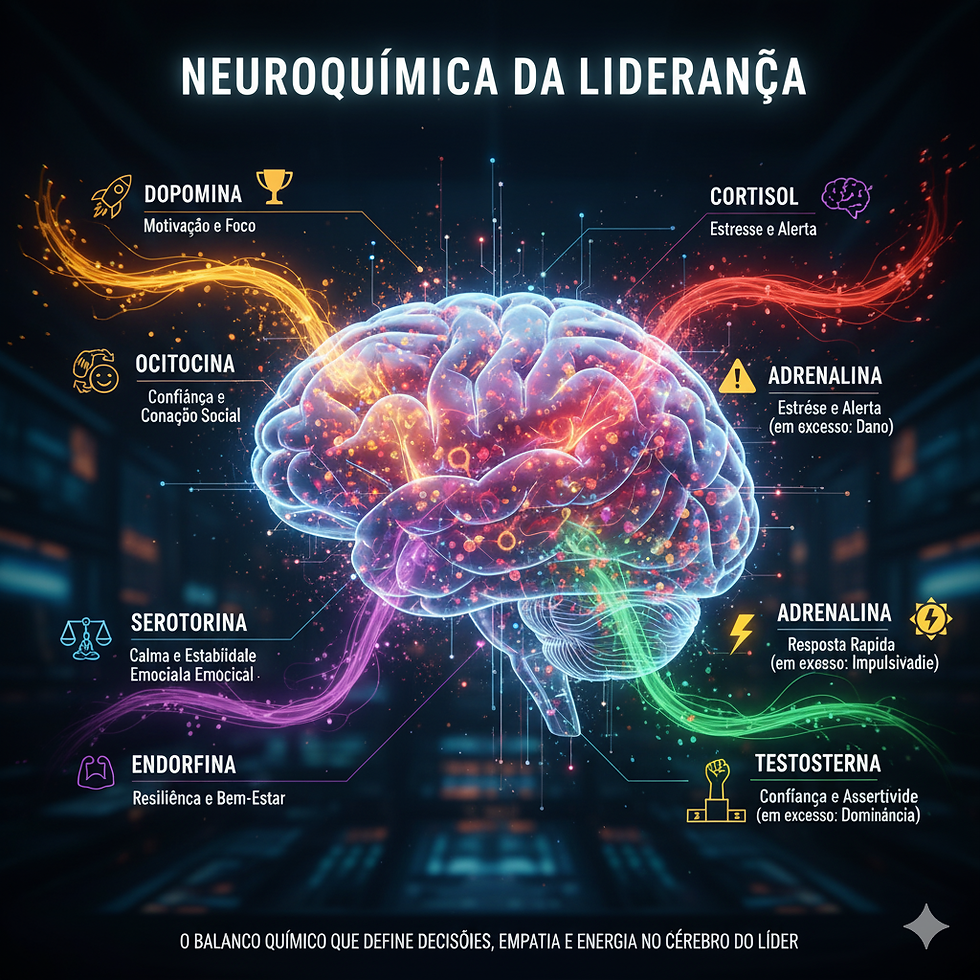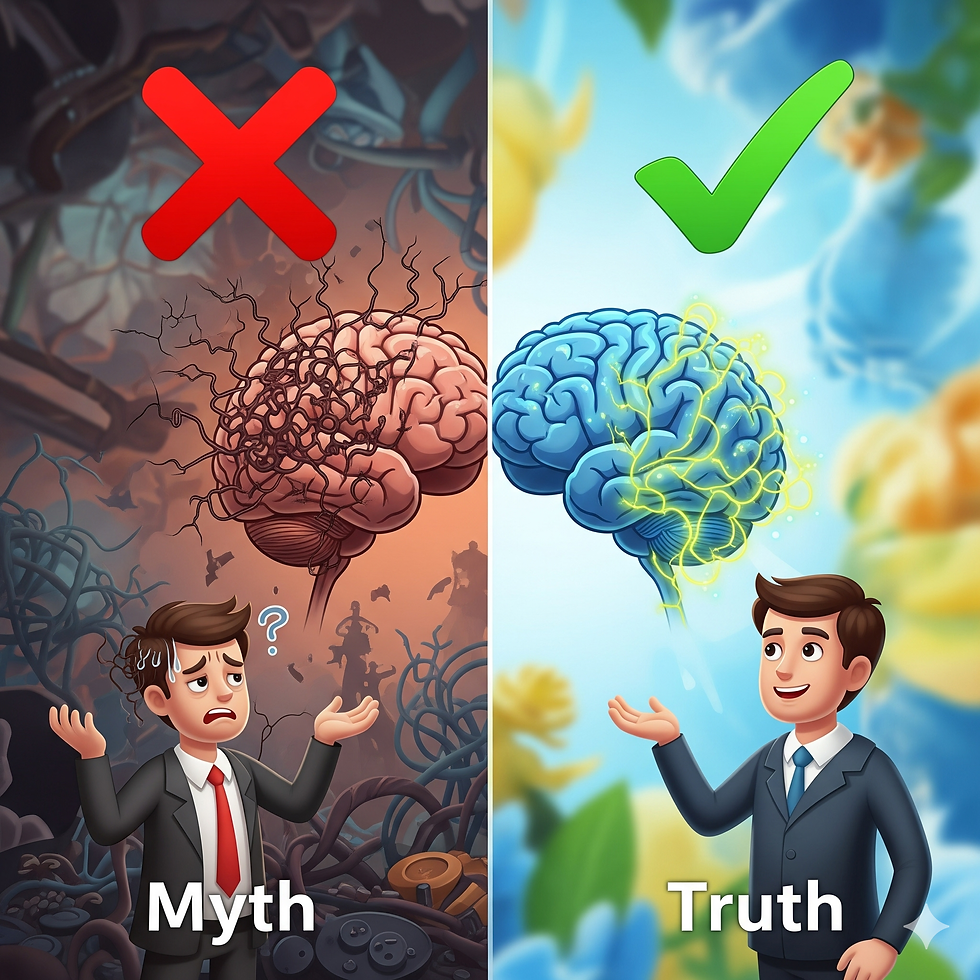NEUROSCIENCE OF LEADERSHIP: How the Brain Shapes Decisions, Empathy, and Stress
- Marcela Emilia Silva do Valle Pereira Ma Emilia
- Sep 4
- 6 min read

💡 Neuroscience of Leadership: How the Brain Shapes Decisions, Empathy, and Stress
If you think leadership is only about strategy, spreadsheets, and goals, it’s time to look up — literally — and focus on the brain.
Remember when I said the brain is a social organ? And that a leader, more than anyone in a company, is in the spotlight and needs enough emotional intelligence to sustain themselves and influence those around them?
So, leading is, above all, a neurobiological act: your nervous system is in charge, deciding whether you inspire, underestimate, destabilize, or sabotage yourself and your team.
🧠 1. The Neuroscience Behind Effective Leadership

Being a leader is not just about “performing well” in meetings. The brain of a leader ends up working and building new pathways different from those of followers, due to the neuroplasticity this organ must manage daily.
It is part of a leader’s routine to face different challenges that require creativity and agility to solve and/or delegate them to the right person. This network of excitement, releasing the adrenaline of work, is both beneficial and harmful. But by keeping endorphin levels stable, the leader maintains positive perspectives and resilience in stressful moments.
👉 In practice, the leader’s brain functions differently and under pressure, dealing with key elements:
🧩 Frontal Cortex: Especially the ventromedial prefrontal cortex, which plays a central role in integrating internal and external factors to execute complex behavioral and mental responses. Also responsible for logical reasoning, planning, emotional control, and moral behavior. This is where intelligent, thoughtful decisions are born.
❤️ Limbic System: Including the amygdala and hippocampus, it mainly regulates emotions and social interactions. Most importantly, it detects threats and triggers rapid emotional responses. This helps leaders manage stress (and avoid amygdala hijacking!), control emotions, and be empathetic with others.
👥 Mirror Neurons: Essential for leadership, as they allow the leader to understand and empathize with followers and peers by mirroring their actions and emotions. This supports social intelligence and helps leaders build stronger teams.

The "mirroring" concept of emotions and actions 🔄 Neuroplasticity: The ability to adapt and build new brain connections allows leaders to develop cognitive flexibility, adjusting behavior and thought processes to fit new or changing situations.
⚖️ Emotional Regulation: The ventromedial prefrontal cortex and limbic system work together to regulate emotions, essential for stress control, positive interactions, and focus on organizational goals.
🎯 Reward System: The fuel of motivation for both leader and team, it drives engagement and positive results through a sense of belonging. The ability to provide positive (even corrective) feedback creates bonds between leader and collaborator, increasing goal-focused work.
💙 Empathy Network: Being an altruistic leader who demonstrates emotions brings them closer to the team, showing humanity and allowing emotional openness. This strengthens trust and mutual collaboration.
👉 Every brain activity has a bodily response. In a leader’s mind, these responses directly influence decision-making, emotional regulation, and social relations. The effects are seen through neurotransmitters and hormones:

Dopamine: Keeps leaders motivated, helps set goals, and provides satisfaction when achieved. High levels increase determination and focus.
Oxytocin: The “bonding hormone,” creates trust, empathy, and social interaction. It sustains a collaborative and social environment.
Cortisol: The stress hormone. In moderate levels, it helps leaders stay alert and focused. In high levels, it harms decision-making and relationships. Effective leaders learn to balance it.
Serotonin: Regulates mood and emotional stability. Balanced levels bring calmness, resilience, and positive interactions.
Adrenaline (Epinephrine): Activates the fight-or-flight response, helping leaders react quickly. In excess, it leads to impulsive decisions and burnout.
Endorphins: Natural painkillers that improve mood, helping leaders stay resilient and positive under stress.
Testosterone: Strongly linked to confidence and assertiveness. In balance, it enhances leadership presence; in excess, it can cause aggression or dominance.
⏳ 2.How Stress Impacts the Leader’s Brain and Body

Stress is not a villain by nature — when managed well, it can even be beneficial:
Positive stress (eustress) ✅: that nervous excitement before a presentation that makes you more alert and focused.
Negative stress (distress) ❌: constant pressure that drains energy, clouds thinking, and increases conflict.
👉 Leaders are constantly exposed to stress limits, so it’s essential to identify when distress becomes routine. Otherwise, results will suffer.
Effects on the brain:
🧩 Cognitive difficulties: Chronic stress impacts the prefrontal cortex, impairing decision-making, problem-solving, and emotional regulation.
📚 Memory and learning: Affects the hippocampus, reducing the ability to retain new information and adapt to challenges.
💥 Emotional regulation: Heightens amygdala activity, increasing fear, anxiety, and impulsivity, harming relationships and leadership effectiveness.
Effects on the body:
❤️🔥 Cardiovascular health: Excess cortisol and adrenaline raise heart rate and blood pressure, leading to long-term heart risks.
🛡️ Immune system suppression: Chronic stress weakens immunity, making leaders more susceptible to illness.
😓 Muscle tension and fatigue: Causes physical discomfort and low energy, reducing productivity.
😴 Sleep problems: Leads to insomnia or poor-quality sleep, creating a cycle of cognitive decline, fatigue, and reduced performance.
🧩 3. Types of Leaders and Their Brain Impact

Like identity, each individual is unique and non-transferable. Leadership is no different. Each leader has their own style, with strengths and weaknesses; those who adapt their approach based on the context and needs of the team and organisation are the most effective.
So yes, there are different types of leaders, and each is characterised by a different style and approach. These styles are distinct and divided into about eight categories, each with its own style and approach characteristics, differing in the personality, goals, and needs of the leader and the organisation or team.
Thus, the leader's personality must match the company's goals so that they can work together and, more importantly, so that the leader can empathise with their subordinates. Each leadership style uniquely affects the happiness (or sadness), productivity, and success of the employee and the company. The leader has a direct impact on motivation, dynamics, and overall satisfaction in the work environment.
Effective leadership that emphasises empathy, provides support, and is ethical tends to have a more positive effect, with higher employee happiness rates, while negative or manipulative leadership tends to threaten workplace well-being and satisfaction. Therefore, it is crucial to identify four leadership characteristics that can help you understand the type of environment you are in and how to respond: recognise and reverse (when still possible), recognise and run, recognise and avoid, or ideally, recognise and take advantage.
🔴 Toxic leader – Creates a climate of fear, focuses on failures, avoids feedback, and keeps cortisol high in the team, reducing creativity and motivation. → Recognize and reverse (if possible), or recognize and leave.
🟡 Insecure leader – Centralizes power, avoids tough decisions and feedback, lacks vision, and transmits anxiety. → Recognize and reverse (if possible), or recognize and avoid.
🟢 Confident leader – Communicates clearly, inspires, listens actively, shows humility, vision, and focus. Strengthens the “collective prefrontal cortex” of the team, fostering productivity, innovation, and trust. → Recognize and embrace!
💙 Contagious leader – Optimistic, positive, communicative, recognizes achievements, inspires and motivates through positive energy. Activates dopamine and oxytocin, generating connection and engagement. → Recognize and embrace fully!
🚀 4. Practical Tips to Lead with your Brain

• Before deciding under pressure: take a deep breath and wait 5 seconds to avoid automatic or harsh responses.
• Remember: your company is not like others. Avoid solving problems by copying what “everyone else” does. (Remember mom’s advice: “If everyone jumps off a bridge, will you jump too?”).
• 👂 Practice active listening: dedicate real moments to listening without interruption or judgment. This lowers stress hormones (epinephrine, norepinephrine, cortisol), increases trust (oxytocin, vasopressin), and boosts well-being (dopamine, serotonin).
• Establish workplace boundaries: frame requests as being “for the company,” not “for you,” avoiding personalization of conflicts.
• 🎉 Reduce team stress: implement strategic breaks and celebrate small victories together. This shows humility, builds unity, and strengthens affinity.
• Be transparent: honesty fosters long-term trust, so leaders and teams can face challenges without secrecy or isolation.
• Train mental clarity: take 10 minutes a day to reflect before critical decisions. For instance, neuroscience studies show that Monday morning meetings are ineffective, as people are still adjusting to the work rhythm.
❌✅ 5. Mini FAQ: Myths and Truths about Leadership

• FAQ: “Empathy is weakness in leadership”
→ ❌ Myth | ✅ Truth: Empathy strengthens decisions and outcomes.
• FAQ: “The brain can learn to lead better”
→ ✅ Truth: 🧠 Neuroplasticity enables new emotional and cognitive skills.
• FAQ: “Stress always harms”
→ ❌ Myth | ✅ Truth: Controlled stress can improve performance short-term.
•FAQ: “Deciding fast is always better”
→ ❌ Myth | ✅ Truth: Speed without clarity leads to biased decisions.
🌟 Conclusion: Leadership with Your Brain, Not Against It

The best leader is not the loudest, but the one who balances reason, emotion, and human connection.
Leadership is not just about commanding. It is about showing the way, teaching and being willing to learn, being contagious and not toxic, being human — not a superhero.At your next big decision, pause, reflect, and choose to lead with your brain — not against it.


Comments